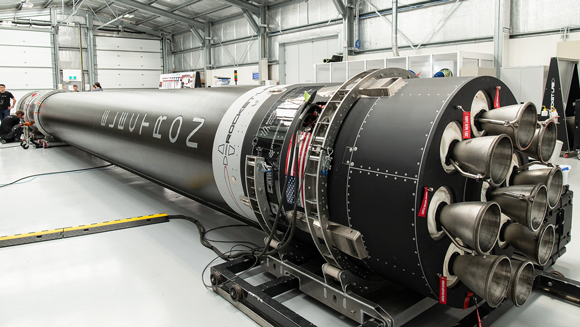Rocket Lab to use pre-flown additively manufactured Rutherford engine in Electron rocket
April 27, 2023

Rocket Lab, Long Beach, California, USA, will take the next step in evolving its Electron launch vehicle into a reusable rocket by launching a pre-flown, additively manufactured engine. Following extensive qualification and acceptance testing, Rocket Lab’s propulsion team has given the engine the green light for re-flight, with the company announcing it will be launched on commercial mission scheduled for lift-off in the third quarter of this year.
The Rutherford engine, previously flown on the ‘There and Back Again’ mission launched in May 2022, has undergone multiple full mission duration hot fires where the pre-flown engine is said to have performed flawlessly and on par with a new Rutherford engine.
While the engine is ready for re-flight now, the Electron rockets scheduled for launch in the second quarter are already built with complete Rutherford powerpack assemblies, so this pre-flown engine will join the production line to be integrated with an in-progress rocket. The engine is one of several recovered Rutherford engines that collectively have now been through many successful full-duration hot fires to support testing and R&D efforts for recovery. The engine joins multiple systems that have been re-flown on Electron including helium press systems.
Re-flying this engine is seen as the latest milestone in the company’s reusability programme that has seen Rocket Lab recover hardware and first stages from six Electron missions to date. Rocket Lab has been developing and testing two recovery methods in parallel; marine recovery where Electron’s first stage returns to Earth under a parachute for a soft ocean splashdown and recovery by boat, and mid-air recovery where Electron’s first stage is caught in the air by a specialised helicopter as the stage descends back to Earth under parachute.
Extensive analysis of returned stages shows that Electron is able to withstand an ocean splashdown and engineers expect future complete stages to pass qualification and acceptance testing for re-flight with minimal refurbishment. As a result, Rocket Lab is moving forward with marine operations as the primary method of recovering Electron for re-flight. This is expected to take the number of Electron missions suitable for recovery from around 50% to between 60-70% of missions due to fewer weather constraints faced by marine recovery vs mid-air capture, while also reducing costs associated with helicopter operations. Rocket Lab will assess the opportunities for flying a complete pre-flown first stage booster following the launch of the pre-flown Rutherford engine in the third quarter this year.
“Electron is already an established workhorse rocket that has been delivering frequent and reliable access to orbit for more than five years. By evolving it into a reusable launch vehicle we plan to further increase our already steadily rising launch cadence, offering more launch availability to our customers at a time when space access is severely constrained globally,” stated Peter Beck, founder and CEO, Rocket Lab. “Reusability for small rockets is immensely challenging as they simply don’t have the fuel margins that larger rockets have to enable propulsive landing.”
“Despite this significant technical hurdle,” he continued, “our team has poured relentless innovation into our reusability programme and proven it’s possible to bring home small rockets and run the engines as good as new. This is a major technical achievement and sets a new standard for small launch vehicles globally. We’re in this position thanks to our diligent engineers designing robust components and over-qualifying them from the outset of the Electron programme to ensure reliability, setting them up well for reuse. We look forward to continuing to rewrite the rules of small launch through reusability, while using the extensive data and experience we’re gathering along the way to inform the development of our Neutron rocket which will be an even greater step forward with a fully reusable first stage, interstage and fairing.”
Rutherford engines are used as both first stage and second stage engines on the Electron launch vehicle, with nine engines on the first stage and a single vacuum optimised engine on the second stage. The sea level versions on Electron’s first stage produce 24 kN (5,500 lbf) of thrust each and with a specific impulse of 311 seconds, while the vacuum optimized version on Electron’s second stage produces a max thrust of 24 kN (5,500 lbf) of thrust and a specific impulse of 343 seconds.
Instead of being powered by traditional gas turbine pumps, Rutherford uses a cycle of brushless DC electric motors and high-performance lithium polymer batteries to drive its propellant pumps. This cuts down on much of the complex turbomachinery typically required for gas generator cycle engines, meaning that the Rutherford is simpler to build than a traditional engine but still can achieve 90% efficiency.
















